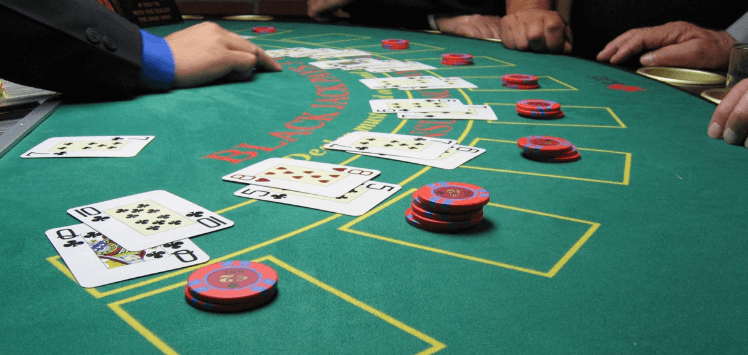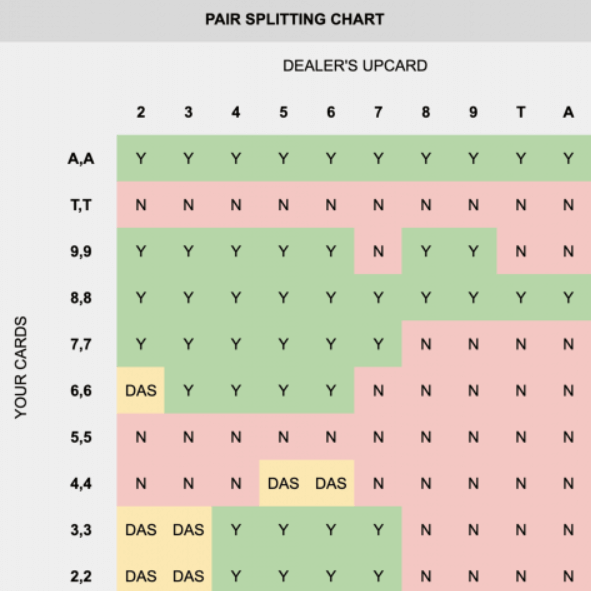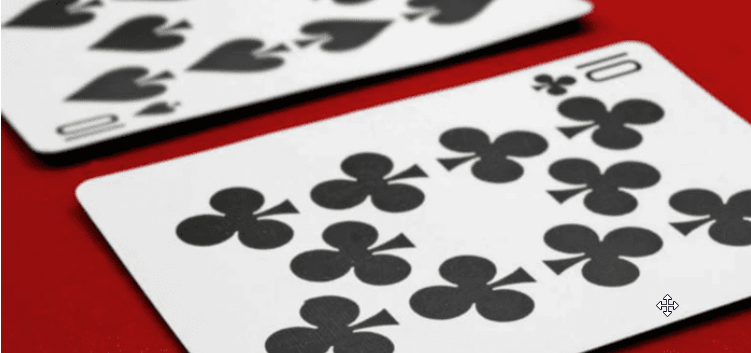When to Split in Blackjack and When Not to: A Full Guide
May 15, 2023
Are you looking to up your blackjack game and increase those winnings? Look no further than the technique of splitting. It can allow players to create two separate hands and potentially double their winnings. However, it is essential to know when to split in blackjack effectively. His Majesty’s Kingdom has prepared a guide to splitting covering everything from strategies and tips to potential pitfalls.
Understanding the Concept of Split in Blackjack
As a quick refresher, let’s define the answer to the question “What is a split in blackjack?”. It is a maneuver that allows players to divide pairs of same-ranked cards into two individual hands. By doing this, they must place an additional bet equal to the initial wager on both new hands and receive one card each for them.

It's important not to confuse splitting with doubling down – where gamblers double their bets and are dealt only one final card. Splitting usually occurs when players get a pair at the beginning of a round.
While a split can increase the odds of having a winning hand, it can also be a bad deal if not done strategically. Therefore, players must understand when to split in blackjack and when to hold back. It should not be impulsive but instead based on a sound strategy that considers many factors.
Blackjack Splitting Cards Strategies
One widely respected method involves consulting a basic blackjack strategy chart, which provides statistically-backed answers to the question “When should you split in blackjack?”. These charts consider both the player's hand and the dealer's up card to suggest the most advantageous course of action. By following these guidelines, you can significantly improve your winning prospects. Just remember, no strategy is foolproof, and the excitement of the game lies in its unpredictability.
For example, according to these charts, players should always split a pair of Aces and eights, regardless of the dealer's upcard. This is because splitting Aces gives you the opportunity for a strong hand with a value of 11 while splitting eights helps you avoid a weak hand with a value of 16. On the other hand, pairs of twos, threes, or sevens are typically better off being hit instead, as splitting them might not substantially improve your chances of winning.

By mastering these strategies and understanding the nuances of split charts, you'll be well on your way to becoming a more formidable blackjack player. So, play wisely to enhance your gameplay and increase your chances of success.
While there may be other strategies on when to split in blackjack, they are not as widely recognized as the basic strategy charts. However, it's essential to remember that each game is unique and may require flexibility in decision-making.
Identifying Split Opportunities in Blackjack
Now it's time to learn all the blackjack split rules and opportunities to increase your winnings. We will provide a complete list of general guidelines to follow when deciding whether or not to split:
- Always split Aces and eights. If you have Aces, it allows you to get two hands with a value of 11, potentially leading to a strong hand. Splitting eights helps you avoid a weak hand with a value of 16, allowing you to turn it into two hands with a value of 8 each.
- Consider splitting when the dealer has a weak upcard. If the dealer's up card is between 2 and 6, they will likely bust. In this scenario, splitting low pairs (2s, 3s, or 6s) can be beneficial, as the dealer's weak upcard increases the chances of both new hands winning.
- Split 9s when the dealer's up card is between 2 and 9 (except 7). If the upcard is 2 through 6, or 8 or 9, it may be wise to split 9s, as it can create two strong hands. However, if the dealer's up card is a 7, avoid splitting, as their potential hand value is 17, and you already have a strong hand with a value of 18.
- Split 7s when the dealer's up card is between 2 and 6. When the dealer has a weak upcard, splitting 7s can be advantageous, as it can lead to better hands that capitalize on the dealer's potential to bust.
- Split 6s only when the dealer's up card is between 3 and 6. Splitting these pairs can create two hands with potentially better values and increase your chances of winning.
- Split 4s only if doubling down after splitting is allowed and the dealer has a weak upcard (5 or 6). Typically it's not advisable to split fours as they're already considered low cards; however, in specific circumstances where you have an opportunity for stronger hands by doing so, it might be worth considering.
These strategies can give you a good idea of when to split pairs. However, it's important to note that these are general guidelines and may not apply in all situations or games. Additionally, consider the number of decks used and any specific rules like resplitting.
Recognizing When Not to Split in Blackjack
While knowing when to split in blackjack is important, recognizing situations where the move can hurt you is equally crucial. Below are some scenarios where a player should not consider splitting their hand:
- Don't split 10-value cards. Splitting 10-value cards (10s, Jacks, Queens, or Kings) is generally a poor decision, as having a hand value of 20 is already strong. Breaking up a 20 into two different hands increases the risk of ending up with weaker hands and reduces your chances of winning.
- Don't split 5s. As mentioned earlier, splitting 5s is inadvisable, as it takes away the opportunity to get a strong hand with a value of 10. Instead, consider doubling down if the dealer has a weak upcard (2 through 9), as this can increase your potential winnings.
- Avoid splitting 4s. It can result in two weak hands, making it more challenging to beat the dealer. Instead, hitting and trying to improve the hand value is better. However, if the rules allow for doubling after splitting and the dealer has a weak upcard (5 or 6), some players might consider splitting 4s a more aggressive play.
- Don't split against a strong dealer upcard. If the dealer has a strong upcard, such as an Ace, 10, or 9, it's best not to split, as there's a higher likelihood that the dealer will end up with a strong hand. In this situation, it's better to play conservatively and try to improve your hand by hitting or standing based on your current hand value.

As noted earlier, specific blackjack split rules will also impact gameplay decisions. Many tables won’t allow further resplitting your hands once done – adding weightage while deciding whether or not to do so originally.
Possible Drawbacks of Splitting Cards in Blackjack
While splitting can bolster one's potential winnings, some drawbacks remain. Here are a few pitfalls of this strategy:
- It requires additional bets. Players must place an extra wager equal to the initial bet for each split hand, which increases financial risk.
- It can lead to weaker hands if not done strategically. As much as splitting pairs leads up to two separate hands challenging the dealer, it also means that there is potential for both splits to result in weak card values leading you closer to busting or losing out on potentially stronger combinations.
- Some players may become too reliant on this technique and use it more often than necessary, leading to decreased winnings.
In conclusion, mastering the art of splitting in blackjack can improve your gameplay and increase potential winnings. By understanding when to split and following proven basic strategy charts as a guide, players can decide whether to divide pairs into separate hands. But remember that every game is unique, so employ some flexibility while using these strategies.
FAQ
How Often Can You Split?
The number of times you can split depends on the casino or table rules. Generally, players can split up to three times, resulting in four hands. However, some casinos might permit fewer splits or have specific rules for splitting certain card combinations. It's essential to familiarize yourself with the house rules before playing to make the most informed decisions.
Which Cards Are Eligible for Splitting?
Cards that can be split are typically any pair of same-value cards. This includes pairs of numbers, face cards (Jack, Queen, King), or Aces. However, some casinos may have specific rules regarding splitting certain card combinations, like only allowing Aces to be split once.
Is the Dealer Allowed to Split?
The dealer is not allowed to split. Dealers follow a predetermined set of rules that dictate their actions, such as hitting on a specific hand value or standing on another. Unlike players, dealers don't have the option to make strategic decisions like splitting, doubling down, or surrendering. This fixed set of rules helps maintain a consistent and fair gaming experience for all players at the table.
< Back to the blog










